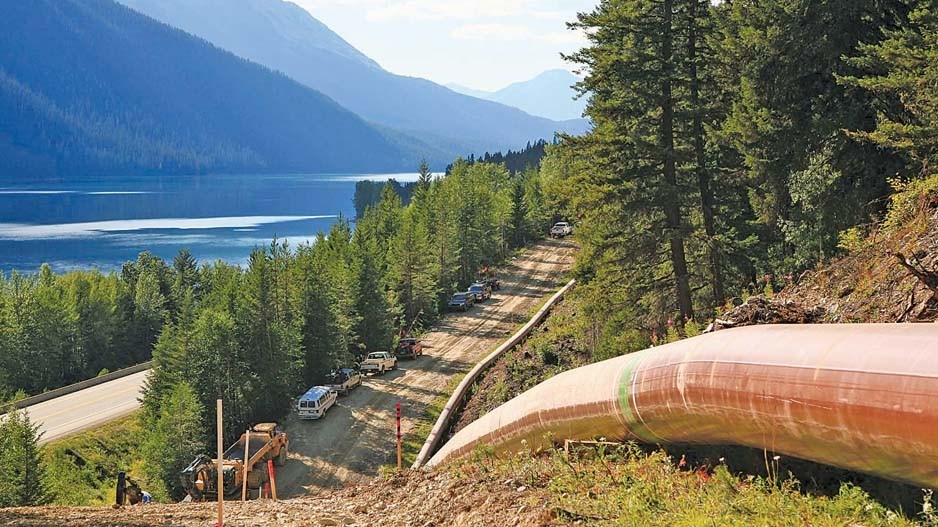Part 2 of two-part series
The global pandemic cut Canada’s 2020 oil production by 7%, while consumption of aviation fuel and gasoline fell 46% and 9%, respectively, according to the Canadian Energy Regulator (CER).
And yet throughout the pandemic, the Trans Mountain pipeline had no space to spare. It was full, said Trans Mountain Corp. CEO Ian Anderson.
“With the challenges of the pandemic and the evolving energy markets around the world this past year, with questions around production and demand, we’ve been asked: Is the project still needed?” Anderson said last week in an energy forum sponsored by Bennett Jones and hosted by the Greater Vancouver Board of Trade (GVBOT).
“The short answer is yes – in fact, never more so. The pipeline has been full every day since 2008. The demand for space exceeds our capacity. And, yes, the pipeline remained full even when demand and prices were at their lowest earlier this year. In fact, this summer, we had a record amount of product go through our line.”
But will it be full in 2030 or 2040?
CER raised that question in its recently published Canadian energy outlook.
It forecasts Alberta’s daily crude oil production to increase by close to one million barrels over the next two decades – hitting 5.8 million barrels per day (MMb/d) before declining to 5.3 MMb/d by 2050.
The forecast notes that three new oil pipeline expansions are underway or expected to start soon: the Trans Mountain twinning project, which would add 540,000 b/d of capacity, Line 3 (370,000 bp/d) and Keystone XL (830,000 b/d).
If all three are built, it would add 1.7 MMb/d of pipeline capacity, while the CER forecasts Alberta’s oil production to grow by only about one MMb/d.
Some of the excess capacity would be taken up by production that has often had to move by rail, which is more expensive than pipelines.
But the new CER outlook raises questions about whether Canada needs three pipelines. And if only two are needed, which ones should be built and which ones shelved?
Both Keystone XL and Line 3 would serve a single market: refineries in the U.S. Gulf coast and Midwest. Because of its West Coast access to tidewater, Trans Mountain can, and does, serve markets other than the U.S. It is flexible both in the types of products it can carry and the markets it serves.
“Why are we full when others are not?” Anderson asked in last week’s panel discussion – a question he then promptly answered.
As a batched pipeline, the Trans Mountain pipeline can move unrefined oil and refined petroleum products. So it is flexible in terms of product, he said. It serves refineries in Burnaby and Washington State with direct pipeline access. It can also fill tankers destined for California and Asia. So it is also more flexible in the markets it can serve.
The Trans Mountain expansion project is now more than a year into construction, with about 7,000 workers employed on the project. Peak construction will begin in the spring and summer of 2021. The company spent $2.2 billion on the project in 2020’s first nine months, according to recent third-quarter financial statements.
When the twinning project was first approved, Kinder Morgan (NYSE:KMI) owned it and had secured contracts with shippers to fill 80% of the new pipeline. Those commitments are still in place.
A string of regulatory delays and court challenges soured Kinder Morgan on the expansion project, spurring the Justin Trudeau government to step in and buy the Trans Mountain pipeline for $4.5 billion, with a commitment to spend roughly $8 billion more to complete the expansion.
When the twinned pipeline is commissioned in late 2022, the government hopes to sell it. A number of First Nations groups have expressed interest in taking an equity position in it. Anderson noted that all Canadians now have a stake in the pipeline, its expansion and its benefits.
“So you will be pleased to hear that the return on Canada’s investment is solid,” Anderson said. “Today cash generated by the pipeline system is about $185 million per year. After expansion, that cash will increase by eightfold. It will be firmly in excess of $1.3 billion per year.”
As for whether Canada could end up with surplus pipeline capacity, Anderson said that is not a bad thing to have.
“You don’t build just enough pipe to move production,” he said. “[Pipelines] must contain excess space to allow for market changes, they must allow for growth and they must ensure flexibility to different markets at different times. Just enough space is not enough.”
One big question mark hangs over Canada’s oil and gas industries, however. The Trudeau government has committed to slashing greenhouse gas emissions to zero by 2050.
Emissions from the oil and liquefied natural gas that Canada exports would not count in Canada’s carbon ledger when burned in other countries, but the emissions generated in its production in Canada would.
So if Alberta is still to produce 5.3 MMb/d in 2050, and Western Canada is to export up to five billion cubic feet per day of LNG, it’s not clear how Canada will meet its net-zero commitments, although increased carbon capture and storage (CCS) is likely to play a significant role.
To make CCS economically viable, carbon pricing needs to be around $60 per tonne. The federal carbon price is set to hit $50 per tonne in 2022. The CER forecasts the carbon tax will rise to $75 per tonne by 2040, and to $175 per tonne by 2050.
It forecasts an additional 15 megatonnes (MT) of carbon dioxide per year will be sequestered by 2040 and 30 MT per year by 2050




